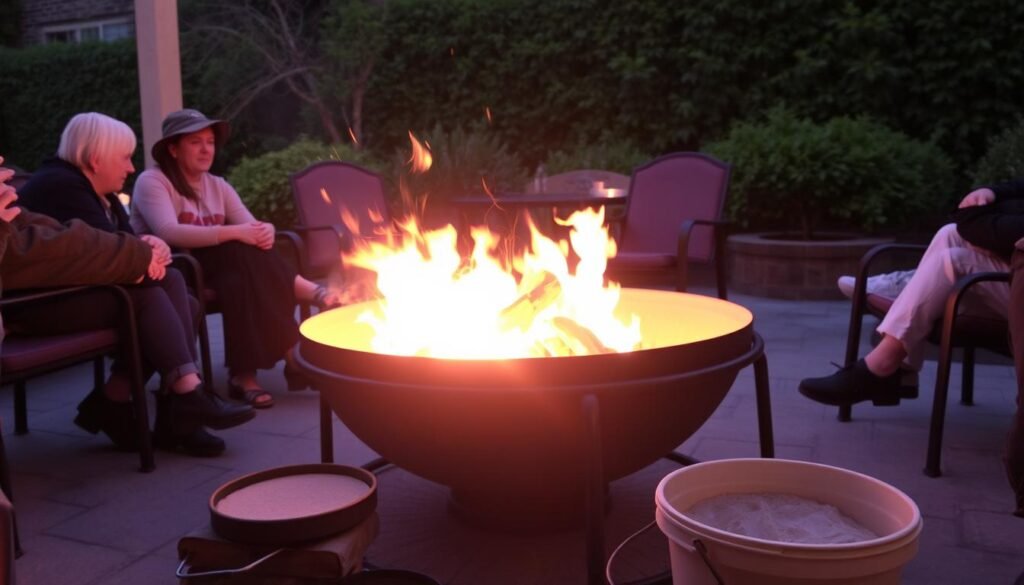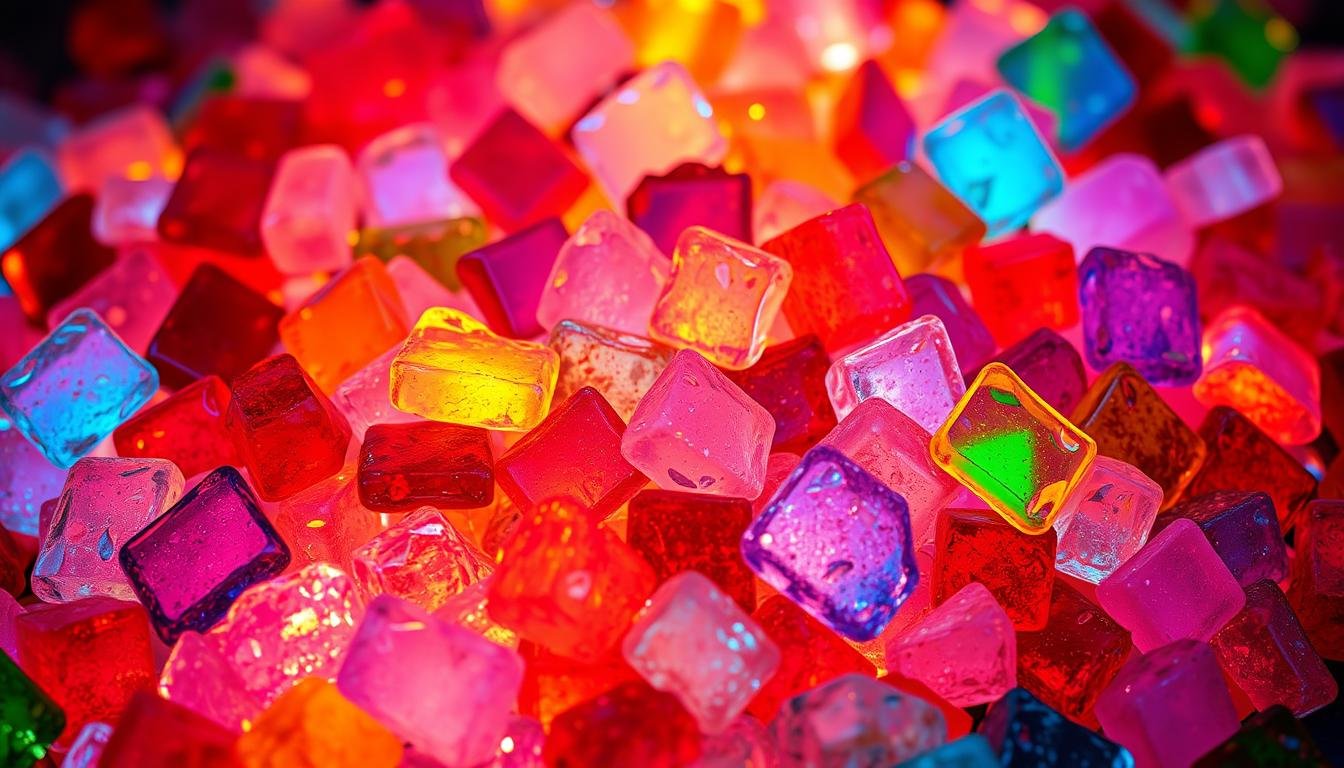Did you know that unintentional actions are the leading cause of outside fires? This highlights the importance of being cautious during outdoor activities, especially when using a fire pit1. Whether you’re roasting marshmallows or enjoying a cozy evening, safety should always come first.
Fire pits come in various types, including wood-burning, liquid propane, and natural gas. Each has its unique charm, but they all require careful handling. Placing your fire pit at least 10 to 20 feet away from structures and flammable materials is a key step in preventing accidents2.
Following local fire codes and regulations is equally important. These guidelines are designed to protect you, your property, and your loved ones. With the right precautions, your outdoor gatherings can be both memorable and safe.
Let’s explore how proper safety measures can enhance your outdoor fun while keeping risks at bay.
Understanding Fire Pit Safety Basics
A little knowledge goes a long way in preventing accidents. Whether you’re hosting a backyard gathering or enjoying a quiet evening, understanding the basics ensures a safe and enjoyable experience.
Why Safety is Essential for Fire Pits
Outdoor heat sources can pose risks if not handled properly. Sparks from wood-burning units or unexpected wind gusts can quickly escalate into hazards. Knowing the material properties of your setup is crucial for minimizing these risks3.
For example, seasoned hardwoods like oak produce fewer sparks compared to softwoods like pine. This small detail can make a big difference in maintaining a safe condition around your outdoor space3.
Overview of Common Risks and Precautions
Environmental factors like wind can significantly alter the risk level. Always ensure there’s enough space between your heat source and flammable objects. A clear line of at least 10 feet from structures is recommended4.
Using a spark screen is another effective precaution. It helps contain embers and prevents them from floating into unwanted areas5. Additionally, placing your setup on non-flammable surfaces like stone or sand adds an extra layer of safety3.
By following these simple steps, you can create a secure environment for everyone to enjoy. Always check local guidelines to ensure compliance with clearance requirements and other regulations.
Essential Fire Pit Safety Equipment and Gear
Ensuring a safe and fun experience starts with the right equipment. Whether you’re using a gas or wood-burning setup, having the proper tools can make all the difference. From regulators to extinguishers, each piece plays a vital role in maintaining a secure environment6.
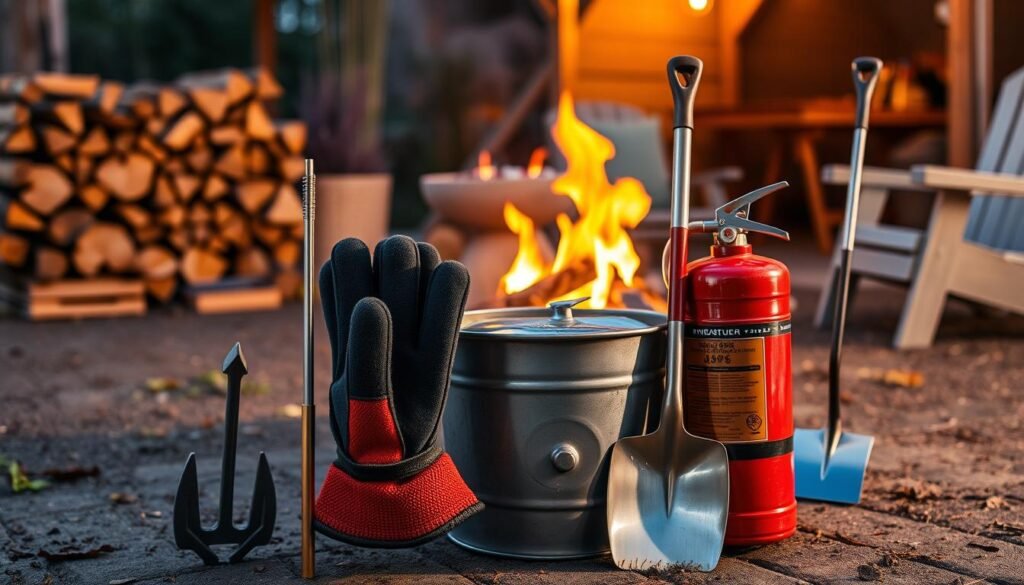
Choosing the Right Gear
Selecting the appropriate gear depends on your setup. For gas units, ensure you have a high-quality regulator and inspect hoses regularly for leaks6. A fire extinguisher is a must-have for emergencies, especially when using flammable fuels like propane6.
For wood-burning options, tools like a spark screen or heat deflector can help manage heat and prevent accidents7. Always choose equipment that matches your specific needs and follows manufacturer guidelines.
Maintenance and Inspection Best Practices
Regular upkeep is key to long-term safety. Inspect your gear annually, focusing on hoses, regulators, and extinguishers6. Clean your setup after each use to prevent debris buildup, which can pose risks8.
Keep a water source nearby for emergencies, and know how to use it effectively. Proper maintenance not only ensures safety but also extends the life of your equipment.
| Equipment | Purpose | Maintenance Tip |
|---|---|---|
| Gas Regulator | Controls gas flow | Inspect for leaks annually |
| Fire Extinguisher | Emergency use | Check pressure monthly |
| Spark Screen | Prevents embers | Clean after each use |
By following these tips, you can create a safer and more enjoyable outdoor space. Proper equipment and regular upkeep are the foundation of a worry-free experience.
Safe Fire Pit Placement and Setup
Proper placement is the foundation of a secure outdoor setup. Ensuring your heat source is in the right location minimizes risks and enhances enjoyment. Let’s explore how to achieve this.
Local Regulations and Clearance Requirements
Before setting up, check local guidelines. Many areas require a minimum distance of 10 feet from structures and flammable materials9. This helps prevent sparks from causing accidents. Always comply with these rules to avoid fines and ensure safety.
For wood-burning setups, maintain a 30-foot distance from stacked firewood and your home9. This reduces the risk of embers igniting nearby items. Avoid placing your setup under string lights or power lines to minimize hazards9.
Establishing a Secure Fire Pit Base
Choosing the right surface is crucial. A stable, fire-resistant base like concrete or stone is ideal10. Avoid grass or wooden decks unless protected with a heat shield or pad9.
For added stability, consider metal or construction-grade materials. These provide durability and reduce the risk of accidents. A secure base ensures your setup remains stable during use.
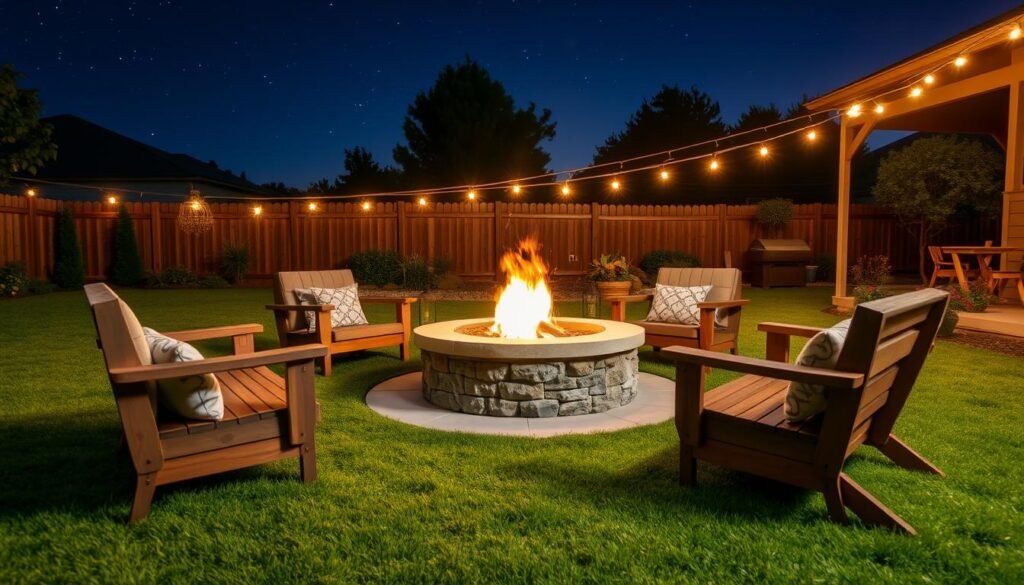
| Material | Benefits | Considerations |
|---|---|---|
| Concrete | Fire-resistant, durable | Requires level ground |
| Stone | Natural look, heat-resistant | May need professional installation |
| Metal | Lightweight, portable | Can get hot, requires insulation |
By following these tips, you can create a safe and enjoyable backyard space. Proper placement and a secure base are essential for a worry-free experience.
Fire Pit Safety on Different Surfaces
Understanding how to adapt safety measures to different surfaces ensures a secure and enjoyable outdoor experience. Whether you’re setting up on a deck, patio, or backyard, the right precautions can prevent damage and enhance your outdoor space.
Deck Safety Guidelines and Protective Measures
Placing a heat source on a wooden deck requires extra care. Decks are more susceptible to damage from heat and sparks, so protective measures are essential. Using a heat-resistant mat or pad can shield the surface from flame and prevent scorching11.
A spark screen is another effective option to contain embers and reduce risks. Ensure the screen fits securely and is made of durable materials. Regularly inspect the deck for signs of wear or heat exposure to maintain its integrity12.
Backyard and Patio Considerations
For patios and backyards, non-flammable surfaces like stone or concrete are ideal. These materials resist heat and provide a stable base for your setup11. Avoid placing the heat source directly on grass or wooden surfaces unless protected with a heat shield.
Using a cover when the heat source is not in use can prevent rust and prolong its lifespan. Choose a cover that complements your home’s aesthetic features while offering maximum protection12.
By selecting the right protective options and following these guidelines, you can create a safe and stylish outdoor space. Proper measures ensure your gatherings are both enjoyable and worry-free.
Managing Different Fire Pit Fuel Options
Choosing the right fuel for your outdoor setup can make a big difference in both enjoyment and safety. Whether you prefer the crackle of wood or the convenience of gas, each option comes with its own set of considerations. Understanding these differences ensures a safer and more efficient outdoor experience.
Safety Tips for Wood-Burning Fire Pits
Wood-burning setups offer a classic ambiance but require careful handling. Always use seasoned hardwoods like oak, as they produce fewer sparks compared to softwoods13. This reduces the risk of embers escaping and causing hazards.
Proper ash disposal is also crucial. Allow the ashes to cool completely before removing them, and store them in a metal container away from flammable materials14. A spark screen can help contain embers and prevent accidents14.
Guidelines for Gas and Natural Gas Fire Pits
Gas setups are known for their convenience and clean burn. Approximately 70% of propane units feature an automatic ignition system, enhancing both ease of use and safety13. Regular inspections of gas lines and connections are essential to prevent leaks14.
Ensure your setup is placed in a well-ventilated area to avoid carbon monoxide buildup14. A standard propane tank can provide 18-20 hours of burn time, depending on the BTU output13. Always keep a fire extinguisher nearby for emergencies13.
| Fuel Type | Safety Tips | Maintenance |
|---|---|---|
| Wood | Use seasoned hardwoods, dispose of ash safely | Clean regularly, inspect spark screen |
| Propane | Check for leaks, ensure proper ventilation | Inspect gas lines annually |
| Natural Gas | Follow local codes, monitor exhaust | Schedule professional inspections |
By selecting the right fuel and following these guidelines, you can create a safe and enjoyable outdoor area. Proper maintenance and careful handling ensure your gatherings are both memorable and worry-free.
Advanced Tips for Preventing Fire Hazards
Taking your outdoor setup to the next level involves advanced precautions that go beyond the basics. These measures ensure a safer and more enjoyable experience for everyone involved. Let’s dive into some expert tips to minimize risks and enhance protection.
Using Protective Barriers and Covers
Protective barriers and covers are essential for shielding nearby areas from stray embers. A spark screen, for example, can contain flying sparks and reduce the risk of accidents15. Similarly, using a heat-resistant mat under your setup prevents heat transfer to flammable surfaces16.
Covers also play a vital role in maintaining your equipment’s longevity. They protect against rust and weather damage, ensuring your setup remains in top condition over time17. Choose durable, weather-resistant materials for maximum protection.
Regular Maintenance and Emergency Readiness
Regular upkeep is crucial for ongoing safety. Inspect your setup for cracks, rust, or other signs of wear after each use15. Cleaning debris and ensuring proper ventilation can prevent hazards from escalating17.
Being emergency-ready is equally important. Keep a hose or fire extinguisher nearby at all times16. Having a preparedness plan ensures you can act quickly if an unexpected situation arises. These steps not only enhance safety but also make your outdoor experience more enjoyable.
Conclusion
Creating a safe and enjoyable outdoor space starts with the right precautions. By following essential guidelines, you can protect your family, property, and surroundings. Make sure to maintain a clearance of at least 10 feet from structures and use materials like sand or gravel for a stable base18.
Regular maintenance is key to long-term safety. Inspect your setup annually, check for wear, and replace materials every 1-2 years19. Keeping a fire extinguisher nearby and monitoring wind conditions can prevent accidents18.
Adhering to local rules ensures compliance and reduces risks. Taking the time each year to review guidelines and update your setup enhances safety and enjoyment. With these measures, your outdoor gatherings can be both memorable and secure.
Source Links
- Outdoor Fire Safety
- Fire Pit Safety Tips | WFCA
- The Ultimate Guide to Fire Pit Safety and Maintenance – The Grove Firewood and Mulch
- Fire Pit Safety: 13 Rules You Should Always Follow
- Fire pit safety | The Hanover Insurance Group
- How to Keep Your Gas Fire Feature Safe
- The 14 Best Fire Pit Accessories | Gear Patrol
- The Best Fire Pit for Your Yard
- Outdoor Fire Pit Safety Tips | Travelers Insurance
- Where To Put Your Fire Pit? The Ultimate Guide To Fire Pit Placement
- The Ultimate Guide to Fire Pit Safety and Maintenance – The Grove Firewood and Mulch
- Safety | Custom Fire Pit Saftey Guide | Seasons Fire Pits
- Propane Fire Pit Guide | Owning an Outdoor Fire Pit
- The Ultimate Guide to Safely Enjoying a Fire Pit Under Your Covered Pa
- The Ultimate Guide to Fire Pit Safety and Maintenance – The Grove Firewood and Mulch
- Fire Pit Safety Tips & FAQs: Your Guide to Safely Using Your Fire Pit
- 7 Tips and 3 Essential Products for Fire Pit Safety | Covers & All Blog
- Fire Pit Safety: Essential Rules for Backyard Enjoyment
- The Ultimate Guide to Fire Pit Safety: Choosing the Right Base for You
Also Read
- Best Fire Pit Glass for Heat Resistance
- Fire Pit Glass Rocks Alternatives
- Fire Pit Glass Rocks Safety Tips
- Fire Pit Glass Installation Tips
- Fire Pit Glass Safety Precautions
- How to Clean Fire Pit Glass
- How Does a Smokeless Fire Pit Work
- How to Build a Smokeless Fire Pit
- Create a Tiki Patio Oasis
- Can One Cook on a Smokeless Fire Pit
- How Far Should a Fire Pit Be From Your House?
- Can You Put a Fire Pit on a Deck
- What to Do with Fire Pit Ashes
- Top Fire Pit Uses
- Can One Cook Food on a Propane Fire Pit?
- Guide to Starting a Fire Pit at Home
- How to Use Propane Fire Pits the Best
- How to Build a Stunning Fire Pit for Your Backyard
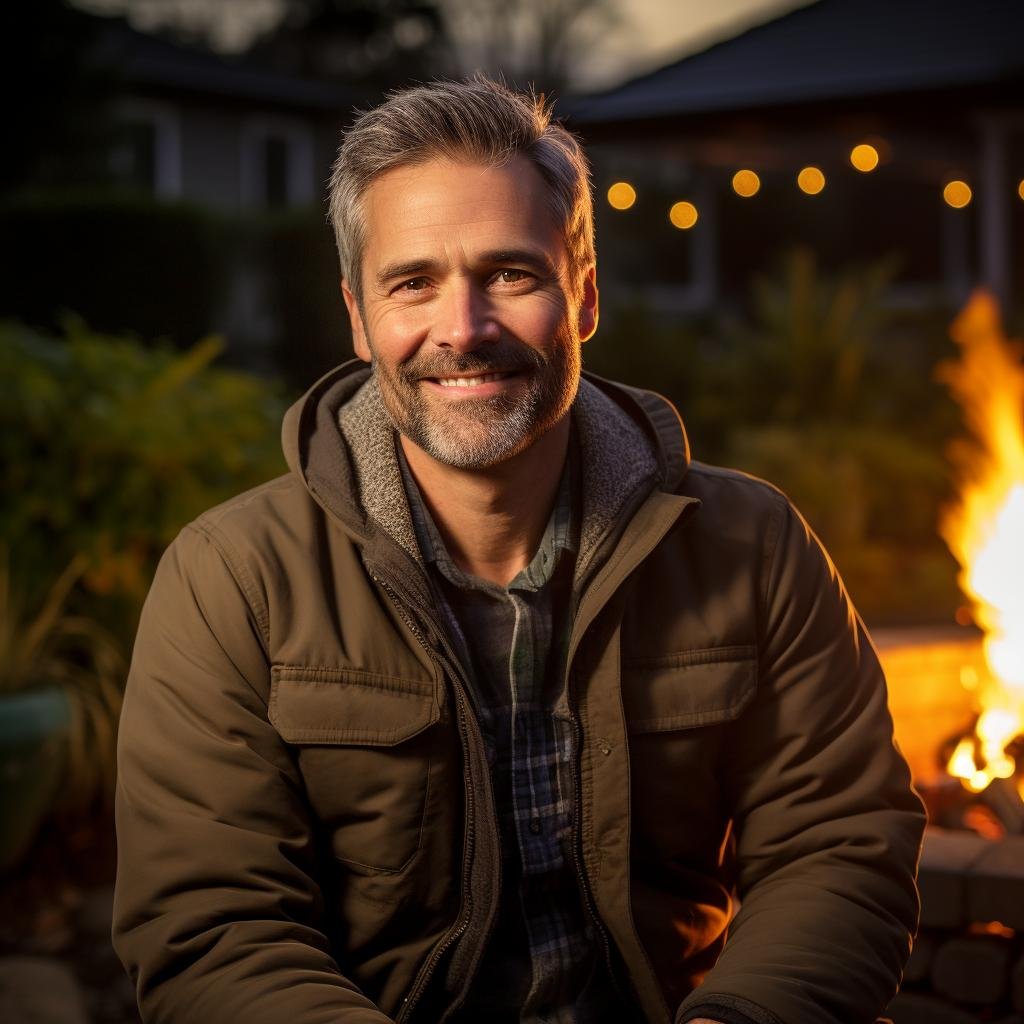
John Carter is a firepit expert with 10+ years of experience in outdoor heating solutions. He specializes in firepit selection, installation, and maintenance, sharing tips on DIY projects, product reviews, and backyard entertainment. Passionate about creating cozy outdoor spaces, he helps homeowners choose the perfect firepit for their needs

